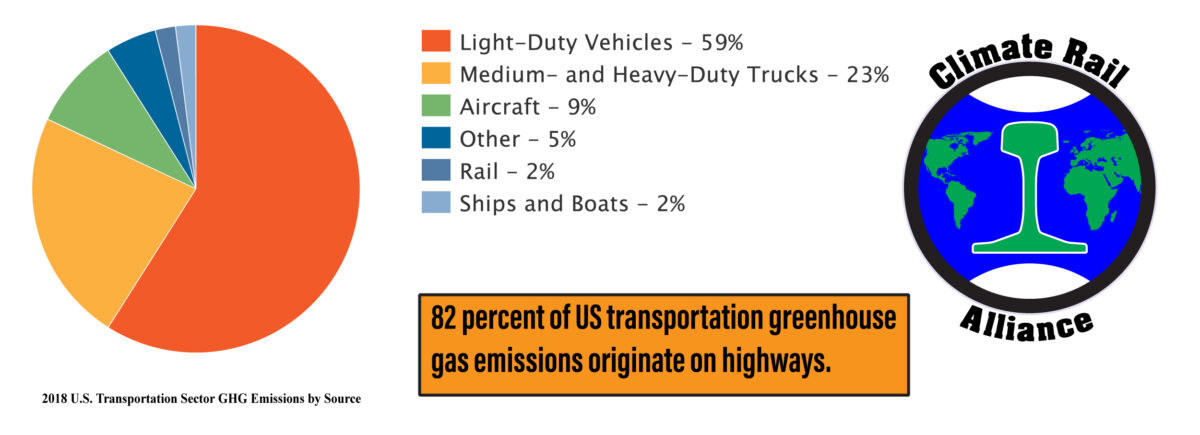The 2022 Washington State Legislature is considering a transportation funding bill that includes funding and service levels, Senate Bill SB5689 and House Bill HB 1786. At the beginning of the session, the bills are virtually identical. Thus my comments below apply to both.
My comments were submitted as formal testimony to the House Transportation Committee. They will be submitted to Senate Transportation Committee members as correspondence.
The material addresses four important rail transportation elements: Amtrak Cascades service levels, rail line abandonment/rail banking, Ultra High Speed Rail, and East-West rail service.
Work on the bills is already started, with the first hearings conducted last week. There is only a short time available to influence the content of the bills.
Senate Bill Link. House Bill Link.
Please feel free to use any of these comments as a basis for your own comments to the House and Senate Transportation Committees. Given the rate of climate change manifestation and the short time left to respond effectively to climate change, these are essential subjects.
In Section 223 (1) directs DOT to reduce costs (p 57 L 10) and to use credits from Amtrak to DOT for…reduced level of service (p 57 L 16)…to adjust corresponding amounts of the multimodal transportation account–state appropriation.
The concept of increasing the equivalent of profit by reducing cost and of reducing service is unacceptable.
Rail transportation uses two-thirds less energy than highway transportation and produces two-thirds fewer emissions. The United Nations Intergovernmental Panel on Climate Change has issued several reports stating that greenhouse gas emissions must be reduced by about 50 percent by 2030 to prevent irreversible climate change. Nationally, highway transportation generates 82 percent of greenhouse gas emissions. Rail generates two percent. As tires wear, they leave toxic particulate on the roadway, that washes off into ground water. Nationally, highway fatalities every month are about equal to the fatalities of the September 11 2001 attacks. Every year, injuries in highway accidents are about the same as the number of US soldiers wounded in combat since 1940. The Amtrak Cascades derailment south of DuPont on December 18 2017 was unacceptable. However, it was the first fatal passenger train derailment in Washington since 1910. In the ensuing three years, there were the same number of highway fatalities, just on I-5 in Lakewood.
Merely concentrating on keeping the same conditions except for substituting Electric Vehicles (EV) for internal combustion vehicles does not address these points. As well, two thirds less energy consumption is important. Converting the amount of highway fuel consumed in Washington into electric power requires the equivalent of two new Grand Coulee dams, five Columbia nuclear power stations, 7,000 wind turbines, or 181 square miles of solar panels. It will generate a new problem, that of EV battery waste. About half of the battery of an EV cannot be recycled or reused. China is the largest EV market in the world. They have had a substantial EV population for long enough to cause a serious battery waste problem. EV batteries may become the new equivalent of nuclear waste. A rapid mode shift from highway to rail is essential.
Mode shift is encouraged by making rail service frequent, convenient, reliable, and attractive, a well-known axiom in the public transportation sector. Those factors are not consistent with cost reduction and service reduction. Although the service must be fast, speed need not be extreme to meet the need. Germany has an extensive network of high speed rail at speeds up to 155 mph on improved existing lines, sharing with freight and lower speed passenger trains.
Washington State developed the Long Range Plan for Amtrak Cascades (LRP) between 1990 and 2006. The plan features substantial improvements to the existing BNSF line that benefit passenger and freight service. The maximum speed of 110 mph allows shared right of way and a two hour thirty minute Seattle-Portland travel time, which is competitive with air travel.
Technical Report 4 of the LRP demonstrates the effect of improved service. Assuming development had continued as planned, the $3.5 million deficit of 2002 would have been reduced to $1.1 million in 2008. By the year of completion, assuming 2023 in the calculations, the Amtrak Cascades service would have a net income of $0.39 million to $2.7 million, depending upon the fare scenario chosen. This was achieved by clock face timetabling (every train operates at the same time every hour; the public doesn’t need a timetable to use the service), assumption of attractive amenities and service, and competitive travel time.
This report was developed under the conditions prevailing in 2006, when the effect of climate change was not well known, and not becoming plainly visible. As well, population growth has been greater than was anticipated in 2006.
Austerity will not increase ridership.
In section 223 (3), funding is established for evaluating rail banking options. At least a substantial portion of the funds must be directed toward determining innovative rail transportation uses of those lines as part of an emphasis on mode shift. There are technologies being developed in Europe and Asia that may make lines that are seemingly useless under the prevailing US rail transportation model that can bring effective transportation to such lines.
In section 223 (4), funding is established for coordination, engagement, and planning of ultra high speed ground transportation. This is an inappropriate use of funds given the climate emergency and the goals established to address it. Such a system cannot be operational for at least thirty years. We must reduce emissions by 50 percent in ten years. The funds would be much better applied to developing rail passenger and improved rail freight service between the Puget Sound area and central/eastern Washington. The cursory work that has been done is not acceptable.
TAW
